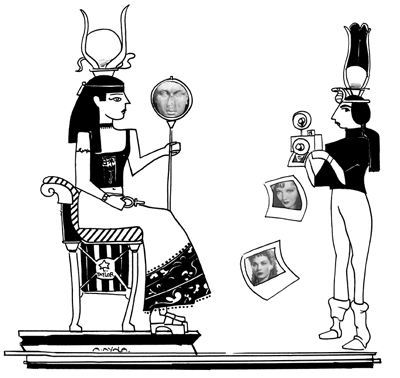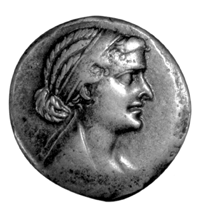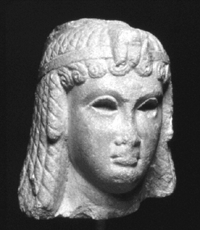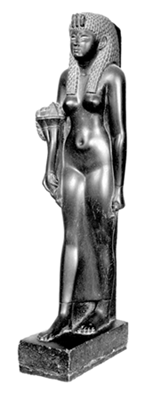
Cleopatra: The Enduring Icon
By Lamaretta Simmons
 Illustration by Alejandro Ayala |
André Malraux, French novelist and art theorist, referred to her as the queen without a face. No statement could be more true when it comes to one of the most universally recognized historical icons. From unabashed temptress to cunning queen to honorable deity, this infamous woman of such conflicting personas is CLEOPATRA - the last and most fêted Queen of Egypt.
For nearly 2,000 years Cleopatra has been the passion of artists and a fascinating conundrum for art historians and archaeologists. She has drawn the attention of artists working in every genre. She is portrayed in stone, in metals, in paintings, in song, on the page and the silver screen. But still, even now, no one knows the real Cleopatra. What did she look like? Was she beautiful? Was she African or Greek, or both? These are just a few of the questions surrounding Cleopatra, and some of the questions that artists, archaeologists and art historians have been haggling with for centuries. What can be said with certainty is that Cleopatra continues to inspire, confound and intrigue.
Hoping to capitalize on the name recognized around the world, the Field Museum chose to participate in showing the exhibit Cleopatra: From History to Myth, which is currently on display until March 3. The brainchild of the British Museum, Cleopatra was designed to be an international three-venue exhibit. Unveiled in Rome in the fall of 2000, the exhibit will close here in Chicago, the only North American stop on its tour. Attempting in part to not only reintroduce Cleopatra to the world, the exhibit also touches upon old wounds, old theories, and misconceptions about her, unraveling preconceived expectations as viewers meander through. The exhibition demonstrates, through nearly every century, how artists from many periods, cultures, and media have created their own - often highly-subjective - images of Cleopatra, how those images have helped to build her mystique, how they continue to renew curiosities, and how representations of her fluctuate according to the social and political mores of various time periods.
But what makes her so intriguing?
Few historical icons, and even fewer women, have elicited the amount of attention as this illfated, terribly complex and elusive ruler. No writer could have conjured up a more awe-inspiring life, a life filled with more than enough scandal and excitement.
Two of Rome's most powerful men loved her. She was called enticing. She ruled with a strong will and left a legacy of insurmountable proportions. She was called great. She defeated male rulers seeking to confiscate her empire and dethrone her, and instilled in her people a sense of pride. She was pharaoh.
Cleopatra's is a legacy tainted with incest, war, death and betrayal. Hers was a life filled with familial conflict, and a constant vigil to preserve Egypt's independence from Rome. Cleopatra, or more specifically Cleopatra VII (the name Cleopatra was a family designation handed down time and again; it was with Cleopatra VII that it became forever linked to just one woman) was born in 69 B.C. and, after ascending the throne at age 17 or 18, ruled Egypt for more than 20 years. At her ascension, by way of custom, she married her 12 year-old brother Ptolemy XIII, whom she eventually battled for control. During this war against her brother she fled Egypt and returned shortly, backed by the forces of Caesar, to defeat her brother and reclaim her place as Pharaoh. Her brother drowned while fleeing Caesar's henchmen. Thereafter, she married her youngest, and last brother Ptolemy XIV, who at the time was just 11 years old.
Cleopatra had a total of five siblings, all of whom preceded her in death. She is said to have had a hand in killing at least two of her younger siblings. Arsinoe, the youngest sister, was killed at Cleopatra's command, by her lover and eventual husband Mark Antony; and Cleopatra is believed to have poisoned Ptolemy XIV, leaving her and her children as sole heirs to the Egyptian throne. These acts alone (there are many more shocking stories about her) support the vision of her as a callous woman, without moral or ethical distractions.
She gave birth to four children, one thought to be fathered by Caesar, called Caesarion (little Caesar), and three fathered by Mark Antony. Upon her suicide, supposedly from the bite of an asp, Caesarion was put to death by Octavian, who succeeded Julius Ceasar, and Egypt became a Roman territory. Cleopatra's other children moved from Egypt to other lands, where they ruled in obscurity.
And so go the skeletal facts.
Inside a Paradox:
A more confounding aspect of Cleopatra's legacy is the scores of representations of her, many of which carry a great deal of political, social, and racial weight, and all of which have been debated by scholars and art historians, and still, there is no consensus on what Cleopatra looked like, or what artifacts - if any - truly represent her likeness.
David Foster, project administrator for temporary exhibitions at the Field Museum, said the challenges in presenting such a disputed icon as Cleopatra were many. Museums are often thought of as places that house history and places to learn facts about a particular topic; however, with Cleopatra, few facts exist.
"There are challenges on many levels. The art historians and the archaeologists who assemble these materials are working with a very small sample ... When dealing with some Egyptian figures, and Cleopatra in particular, the first challenge is that there are very few authenticated surviving pieces. And with a lot of the material, the identifications are conjectural," Foster said.
Mostly comprised of sculptures from the era of Cleopatra's reign, the pieces show variety in the ways in which she has been envisioned. Peppered with images of family members, lovers, and her subjects, the exhibit takes considerable thought in just how it describes each item. Because there is so much dispute surrounding her body and image, many busts and statues of Cleopatra VII are cautiously worded stating that it is "thought to be" Cleopatra VII.
 Unlike historical figures such as Julius Caesar or Octavian, who have an enormous amount of art dedicated to their likeness, Cleopatra VII has very few pieces for comparison in order to make a defendable composite of her face. The exhibit notes that upon her death, Octavian took control of Egypt and set out to destroy the Egyptian style images of Cleopatra VII. The few that were spared were done so after a wealthy Alexandrian paid Octavian to do so. Unlike historical figures such as Julius Caesar or Octavian, who have an enormous amount of art dedicated to their likeness, Cleopatra VII has very few pieces for comparison in order to make a defendable composite of her face. The exhibit notes that upon her death, Octavian took control of Egypt and set out to destroy the Egyptian style images of Cleopatra VII. The few that were spared were done so after a wealthy Alexandrian paid Octavian to do so.
Regarding the ancient models of Cleopatra VII the main contrasts are between those done in the Greek style and those in the Egyptian style. According to recent scholarship, the Egyptian treatments are much more stylized and rarely placed emphasis on true reflection, rather symbols to relay status and royalty. Several of the Egyptian sculptures shown are quite different in facial feature from one another; it is hard to think they depict the same person. However, what combines them all as depictions of Cleopatra VII are the symbols found consistently among them. The most noted is the triple uraeus or the three-cobra headdress, found on nearly all representations of Cleopatra VII.
Foster explained, "There are multiple reasons for multiple portrayals and in the end you are still left with this enigma ... rulers portrayed themselves in various ways for various reasons. When she is portrayed in the Egyptian style, those were religious images, which were done for
the priesthood and the temple community and her subjects ... it was important for them to see her as a Pharaoh and a divine being, but when she was in Rome, she was portrayed as a Roman beauty."
He added that during the course of constructing the exhibit 10 Egyptian style statues of Cleopatra were reidentified by British Museum curators, with support from scholars, as authentic images of the queen.
The Greek style is said to be more naturalistic; however, it has been challenged as an attempt to make Cleopatra appear less Egyptian or African. The Greek style appears more European, as it often maintains a more curly or wavy treatment of the hair and more aesthetically pleasing treatment of her nose - a feature of Cleopatra's which has been much contested.
Profiled on a bronze eighty drachma coin from the period of her rule, Cleopatra is shown as having a long hooked nose, which she is believed to have actually had. The coin is, on the whole, an unflattering portrayal of what would have been a young queen. The "Limestone Head of Cleopatra VII," housed at the Brooklyn Museum of Art, and on display at the Field Museum exhibit, shows a youthful Cleopatra with a small nose and full lips, markedly different from the coin, where Cleopatra appears almost old. However, it should be noted that the coin has been weathered by time, and while in good condition, is nowhere near mint condition.
 The idea of beauty is always changing, and varies from culture to culture, and contemporary ideas of beauty may vary markedly from Cleopatra's time and culture.There is much debate over the issue of her beauty, which is now thought to be as much a myth as anything else about her. Some theories lean towards Cleopatra's power lying not in her beauty, but in her charms and intelligence. The idea of beauty is always changing, and varies from culture to culture, and contemporary ideas of beauty may vary markedly from Cleopatra's time and culture.There is much debate over the issue of her beauty, which is now thought to be as much a myth as anything else about her. Some theories lean towards Cleopatra's power lying not in her beauty, but in her charms and intelligence.
Ugly or not, many imagine her as a beautiful, milk-complexioned woman, as can be seen in various portrait and screen adaptations. Many Americans immediately visualize Elizabeth Taylor at the mention of Cleopatra's name.
Cleopatra as race warrior?
At the onset of the 19th century, the debate over Cleopatra became more grounded in her race than ever before. Images of Cleopatra, at least those considered modern depictions, are often based on debatable scholarship and theory about her dubious lineage, which serve as debate fodder.
Modern scholarship heavily supports Cleopatra's heritage as Macedonian Greek. That theory would seem to stamp out any debate about her race. But opponents offer that despite the fact that Cleopatra's patriarchal line was indeed Greek, her grandmother's heritage is forever lost. All that is known of her grandmother is that she was a concubine and gave birth to both of Cleopatra's parents. (Cleopatra was the result of an incestuous relationship: it was common practice for members of the Ptolemic dynasty to marry their siblings.) This tidbit about her grandmother leads many to speculate that Cleopatra was of mixed heritage, and that
her grandmother was plausibly of African origin, which would explain the lack of records about her and her being a concubine. However, it is considered unlikely given the xenophobic demeanor of the Ptolemies.
 "[Cleopatra] had been portrayed in Western Europe since the Renaissance at least, but she is always portrayed as a blonde, rosy cheeked European beauty, in the European tradition," Foster said. "[Cleopatra] had been portrayed in Western Europe since the Renaissance at least, but she is always portrayed as a blonde, rosy cheeked European beauty, in the European tradition," Foster said.
"After Napoleon's expedition to Egypt in 1798 ... at the same time that the Western European nations were beginning their imperial acquisitions of territories around the world, at that time she begins to be exoticised, her skin gets darker, she looks like an eastern queen and even sometimes an African queen. In the 19th century there was a very distinct shift in the portrayal of her," Foster explained.
The companion catalog to the exhibit, Cleopatra of Egypt: From History to Myth, edited by Susan Walker and Peter Riggs, with an essay by Mary Hamer states: "Today controversy rages again over the body of Cleopatra, and in particular, over her race. When black nationalists in the U.S. lay claim to Cleopatra, as they do, that attempt is surely made in pursuit of dignity ... Countering them are mainly white scholars, who in defense of civilization and scientific knowledge, as they put it, insist that Cleopatra could not have been black..."
Much of the suspicion has been linked to efforts to explain or sanitize her romantic liaisons with Julius Caesar and Mark Antony, both of whom were swept up by her graces and with both of whom she bore children. Racial conspiracy theorists believe that making Cleopatra European- or Roman-looking is simply a stab at rewriting history. How could two of the most significant male rulers of Rome consort with an African or non-European woman so intimately?
The 20th century portrayals of Cleopatra are often wrapped up in the issue of her race, and show how artists have used her as a political propaganda tool. As an example, Hamer points to a famed sculpture by American artist William Wetmore Story. "A Marble Statue of Cleopatra," made in 1858, housed at the Los Angeles County Museum of Art, depicts Cleopatra as she sulks in rejection by Octavian, and according to Hamer, the statue "was initially hailed as an 'accurate' and 'daring' portrayal of a black woman," an observation hard to assume at first glance today. Hamer asserts "[writer] Nathaniel Hawthorne's appreciation of the statue in his novel The Marble Faun indicates the image was picked up as a reference to sexual intimacy between women slaves and white men. In showing Cleopatra as rejected by Octavian the statue was designed to model a white master's disdain for the advances of a black slave ...".
 "As [white scholars] put it, Cleopatra could not have been black. I find myself asking about this passion for certainty, for knowledge that is absolute and final, one that cuts off final debate," Hamer wrote. "As [white scholars] put it, Cleopatra could not have been black. I find myself asking about this passion for certainty, for knowledge that is absolute and final, one that cuts off final debate," Hamer wrote.
Still, Greek, African, or mixed, Hollywood has taken little pain to portray the queen with any diversity. All of Hollywood's Cleopatras have been Caucasian - a far cry even from Macedonian. The 1968 film starring Elizabeth Taylor gained blockbuster success and is still highly regarded as one of the greatest films about Cleopatra. The film solidified Taylor's face as Cleopatra's.
The totality of Cleopatra's racial make-up will probably never be uncovered. Nevertheless, Egypt during Cleopatra's time was not Detroit. Race, of the peculiar American variety, was hardly an issue among the Egyptians. Egyptian citizens came from many places. Culture and citizenship mattered far more. Whatever her race, she was an African queen who governed an African nation and has left her imprint on the world.
The exhibit brings Cleopatra to life, in all her ambiguity, intricacy, and charisma, the exhibit welcomes the inconsistent images of Cleopatra. Claimed by many and captured by none, Cleopatra's legend continues to pelt the world with uncomfortable questions and inspiring imagery. The exhibit is just another step in helping the public come to terms with the imperfect, vulnerable, yet unyieldingly power-driven woman who has captivated the world for centuries. If nothing else, the observer is left not having found the real Cleopatra, but instead having found her many ghosts and incarnations. Instead of confusion, the viewer leaves reconciled to some degree with the reality of the inability to know the real Cleopatra.
Cleopatra: From History to Myth runs through March 3 at the Field Museum 1400 South Lake Shore Drive. For more info call 312-922-9410 or visit www.fieldmuseum.org. Tickets are $10.00 plus regular museum admission. Student and senior discount available.
Images of Cleopatra courtesy of The Field Museum
|

